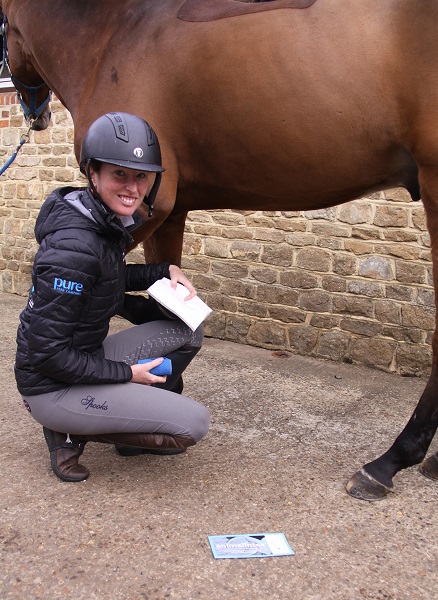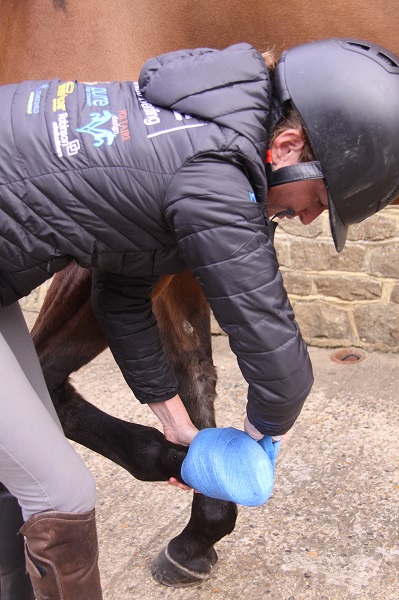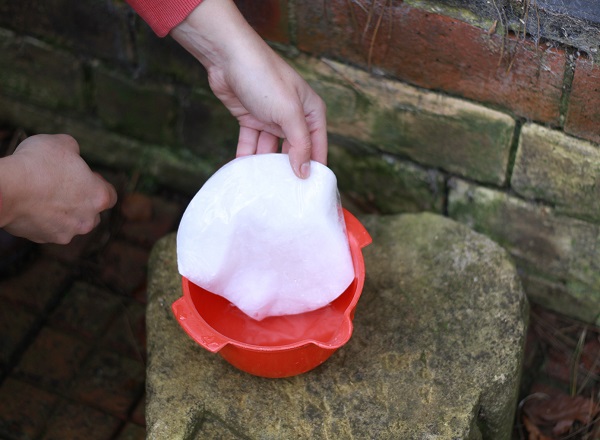Posted: 26th July 2018 | Back to news feed

Emma McNab shows how to poultice a hoof
Here Robinson Animal Healthcare sponsored event rider, Emma McNab offers her advice on perfecting a poultice
Most horse owners will, at some point be faced with a hopping lame horse that has developed a hoof abscess. Very often the lameness can appear suddenly as the amount of pus builds in the foot making it painful for the horse to bear weight.
For professional riders like Emma, this can mean months of training going to waste or even missing out on a much sought after spot on an international team.
Knowing what to do and having the right products and equipment to hand can make all the difference to a speedy recovery and returning to action.
What you need
Emma always keeps Animalintex® in her first aid kit: “It is the only poultice we would use on our horses, as being a licensed product I know it is safe and effective. We try to keep a stock of Animalintex® Hoof Treatment which is hoof shaped but if not we cut standard Animalintex® down to size.”

As well as a licenced poultice, you will need a hoof pick, hygienic sponge and a bucket to clean the hoof prior to poulticing. You will also need some form of padding such as Veterinary Gamgee® and a cohesive bandage to hold everything in place.
Perfect Poulticing
It is extremely important that the poultice is applied to a clean hoof. “Before cleaning the hoof we always ensure the horse is stood in a clean, dry stable to avoid any more bacteria entering the hoof during the cleaning process,” said Emma.
The person applying the poultice should thoroughly wash their hands before beginning, and a saline solution or level teaspoon of salt per pint of previously boiled water should be used to clean the hoof – this is a sterile solution that will help towards preventing further infection entering the hoof.
To treat an abscess, the poultice should be applied hot. To prepare a hot poultice, place the unwrapped, cut to size Animalintex® in a shallow tray (that has been thoroughly cleaned) with the plastic side facing up.

Then, allow boiled water to cool to 38 degrees centigrade and pour the water into the tray around the edges of the poultice, remove from the water when saturated, squeezing out the excess water, so the poultice is damp rather than wet.

Place the poultice on the sole of the foot with the plastic side facing upwards and then cover with a piece of Veterinary Gamgee® that has been cut to shape. Secure the poultice and padding in place using a cohesive bandage such as Equiwrap®, using a figure-of-eight pattern across the sole of the foot.
When treating an abscess the poultice should be changed every eight hours for the first 48 hours.
If in any doubt always consult your veterinary surgeon.
For more information on the Robinson Animal Health Care range contact them on 01909 735000 or visit www.robinsonhealthcare.com
The Equestrian Index newsfeed is compiled from articles submitted by advertising members and expresses the opinions of those members. Watsons Directories Ltd shall not be held liable for any inaccuracies or mis-statements therein.
